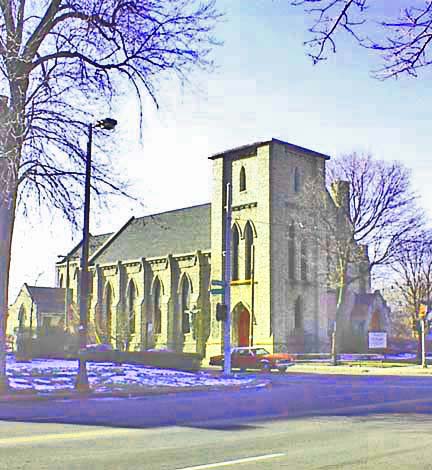 [Under construction: new picture to come]
[Under construction: new picture to come]

Church of the Messiah
251 East Grand Boulevard at East Lafayette
Very near the intersection of MacArthur Bridge and East Jefferson
This is a very attractive church. It is, I believe, the third oldest church standing in Detroit. Detroit Episcopalians erected their first Detroit church on Woodward between Larned and Congress in 1828. It was a plain brick structure designed by Alonzo Merrill. The congregation grew, became more prosperous and, in 1836, they had their plain brick building enlarged and made into a Gothic structure by the Irish architect, Robert T. Elliott. His work was so admired that the Gothic style was adopted as a model for many Detroit churches in that era.
This Episcopalian Church of the Messiah, designed by architect Calvin N. Otis, might be confused with Messiah Church, a German Evangelical Lutheran congregation. Their church is also located on Grand Boulevard but at the intersection of West Grand and Toledo. It has the distinction, I believe, of being the only Detroit church designed in the Jacobean style and may be the most impressive church designed by Spier and Rohns who were famous for their railroad depots. This website includes a page for Messiah Church.
Charlotte Ann Taylor and her sister, Julia Ann Anderson wished to establish an Episcopalian church to serve the religious needs of the many sailors who came to Detroit’s waterfront. Presumably, they wanted Robert Elliott to design their church but he died so they turned to Calvin N. Otis of Buffalo. He designed Mariners’ Church and completed it in 1849. It was moved from its location on the north side of East Jefferson to the south side where it now gracefully complements Hart Plaza and stands in lasting contrast to the Renaissance Center.
By the early 1850s, the Episcopalians needed a new and larger church so they asked Calvin N. Otis to design another church to be located at the corner of Congress and Shelby. He built an early English Gothic style building with lancet windows. He added a steeple to make the church highly visible in Detroit and complemented that steeple with a much smaller turret. The interior of the church was completed in a simple manner reminiscent of a New England meetinghouse. This church became St. Paul’s Protestant Episcopal Cathedral.
At the end of the Nineteenth Century, People’s State Bank desired to build a large and impressive building. This is the striking bank building designed by famous New York architects McKim, Mead and White located at the corner of Fort and Shelby. It was completed in 1901. Calvin Otis’ beautiful church was moved, stone by stone, to the corner of East Grand Boulevard and East Lafayette where it has stood for more than a century. Shortly thereafter the Episcopalians began constructing their cathedral at the intersection of Woodward and East Warren. The relocated church became the Church of the Messiah while the new cathedral retained the name St. Paul’s. Calvin Otis has the honor of being the only architect who designed two architecturally significant churches that were moved from one location to another.
Detroit architect William Stratton supervised the move and redesign of the original church. The tall windows with their stained glass were retained but the original steeple and turret disappeared. William Stratton, as you might anticipate, augmented the renovated church with much Pewabic Tile. This church is an excellent example of how a prosperous Episcopalian congregation in a medium sized Midwestern city conceived of an English Gothic church a decade before the Civil War. This church remains an active parish specializing in assisting those in need. The church and its staff have specialized in promoting the availability of housing for low-income residents of Detroit.
Date of Construction: 1852
Architect: Calvin N. Otis
Architectural Style: English Gothic with a New England meeting house interior
Architect for the move and renovation of the church: William Stratton
Date of removal from downtown to its present location: 1901
Website for this church: http://www.episcopalchurch.org/parish/church-messiah-detroit-mi
Website for the Church of the Messiah’s Housing Corporation: http://messiahhousing.org/
State of Michigan Historical Register: Listed
National Register of Historic Places. The Church of the Messiah is within the East Grand Boulevard Historic District that includes structures on both sides of East Grand from Jefferson to Mack.
Photo: Ren Farley, February, 2003
Description updated: November, 2016